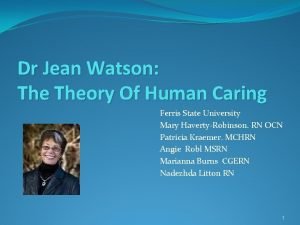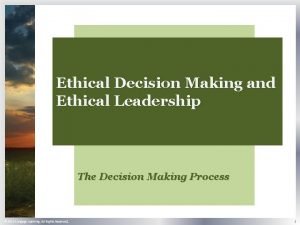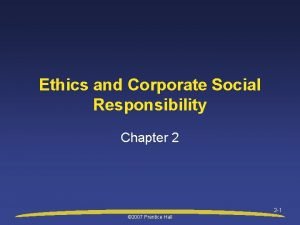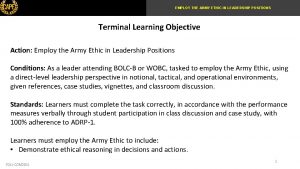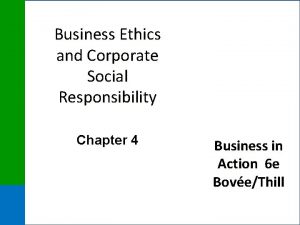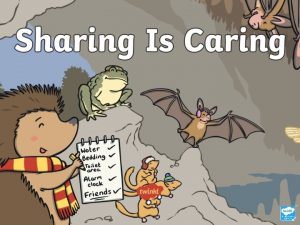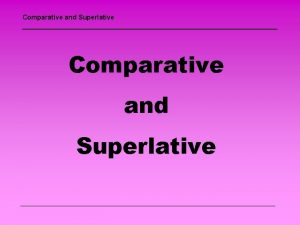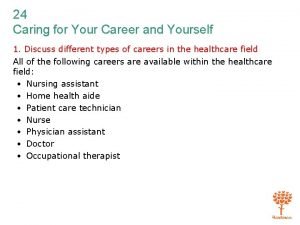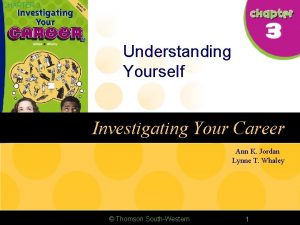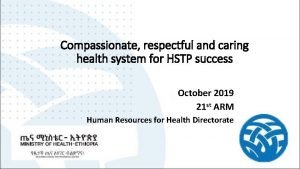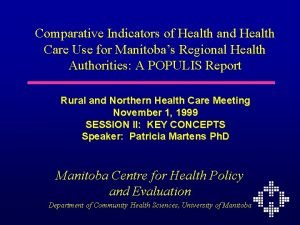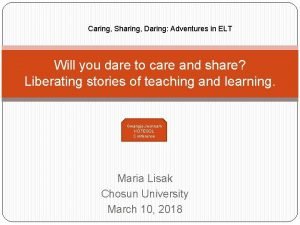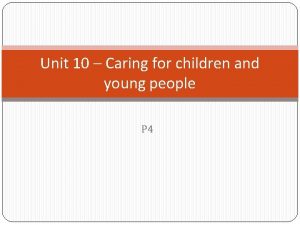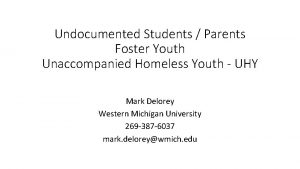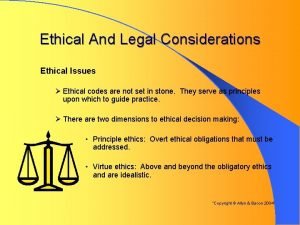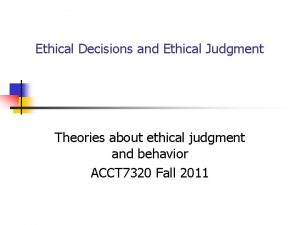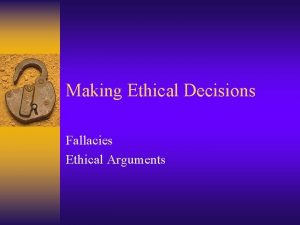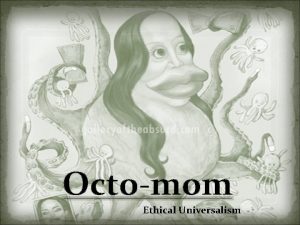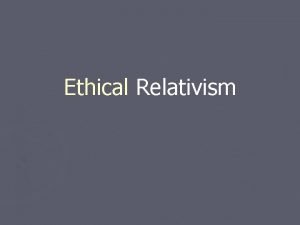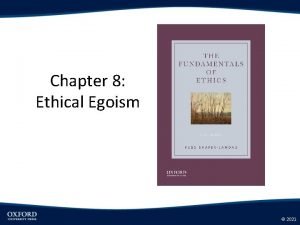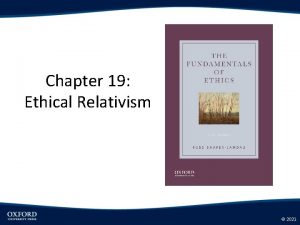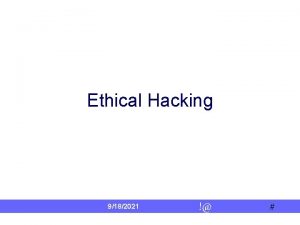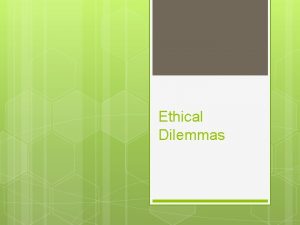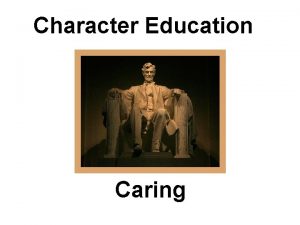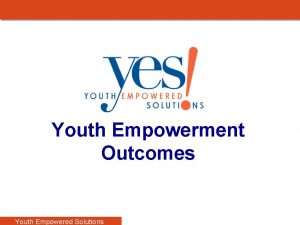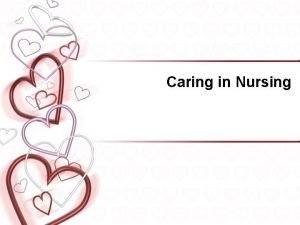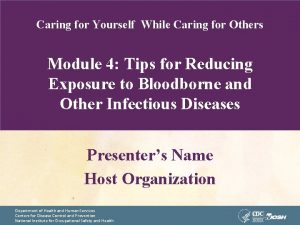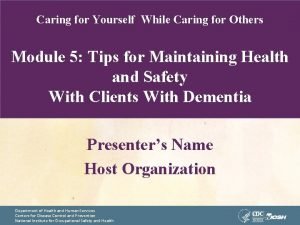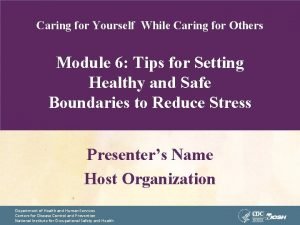Caring for Allying with Undocumented Youth Ethical and






















- Slides: 22

Caring for & Allying with Undocumented Youth Ethical and Practical Considerations Mark Kuczewski, Ph. D @Bioethx. Mark & Johana Mejias-Beck (MS-3) Loyola University Chicago Stritch School of Medicine At the end of this session, participants should be able to 1. Analyze how the encounter with undocumented youth calls medicine to embrace and ally with such patients & community members 2. Identify the barriers to health and health care that face undocumented youth 3. Develop strategies for assisting undocumented youth to maximize their clinic experience and their general well being 4. Identify ways that health care professionals & the public health community must be allies of undocumented communities in the current environment

“What Will Happen to Undocumented Doctors? ” The Atlantic, February 2, 2017 https: //www. theatlantic. com/video/index/515466/what-will-happen-toundocumented-doctors/

Discovering DREAMers The Loyola Stritch SOM Story An e-mail arrived (May 2011). . . A professor at a Jesuit university enquired of the medical school prospects for his student • Near-perfect GPA • Pre-Med double major in Biology & Spanish • Strong volunteer service record • Does not have an authorized immigration status, i. e. , is what is sometimes called a DREAMer

“DREAMer” MDs “DACA-mented” MDs • Outstanding academic qualifications • Personal qualities: Overcame extraordinary life circumstances • Added Value of Diversity • Social Justice – for Patients for Students • DREAMer – From never-passed DREAM Act (2001) – Brought to US > 16 yo, 5 -10 years in US, no significant criminal history, educational attainment

Deferred Action for Childhood Arrivals DACA • Announced by President Obama on 6/15/2012 • Presidential memorandum; an act of prosecutorial discretion • Provides two-year, renewable stay of action for those who meet criteria in never-passed DREAM Act: Brought to US prior to age of 16, lived in US continuously for > 5 years, no serious criminal offenses, attained at least a high school diploma or equivalent. . . • Grants an Employment Authorization Document (EAD) and eligibility for a Social Security number


Welcoming “Through the Front Door” 1. 2. With advent of DACA, non-discrimination joins social justice as important concern – analogy to civil rights era (If no DACA, is there still an analogy to Jim Crow era of segregation, apartheid? ) 3. Dean Linda Brubaker, MD, ordered Admissions Eligibility Criteria amended to welcome applications from persons of DACA status in Fall of 2012: ssom. luc. edu/daca 4. Enlistment of community support through announcing intentions. Aimed to achieve a financial aid package comparable to other students 5. Becomes a “teachable moment” within life of school – opens out to bigger immigration issues 6. 7 DACA recipients in Class of 2018; 14 more in Class of 2019, 8 in Class of 2020

Years 01, 02 & 03 Stritch DACA-mented Students: • 28 Students of DACA status currently enrolled • 6 Third-year students • 14 Second-year students (One MD-Ph. D) • 8 First-year students (One MD-Ph. D) • 17 Different nations of birth represented: Bolivia, Brazil, Cameroon, Ecuador, Guatemala, India, Iran, Lebanon, Mexico, Pakistan, Peru, Philippines, Republic of Korea, Thailand, Trinidad and Tobago, UK, Venezuela • 16 Different States represented: AZ, CA, CO, FL, GA, IL, MI, NJ, NM, NY, OR, SC, TX, TN, VA, WI)

National Emergency?

Lives in Limbo by Roberto Gonzales Undocumented is a “master status” that colors all possibilities, e. g. , driver’s license, work options, health insurance, education DACA began change, e. g. , work permit, driver’s license, but left in place many barriers, e. g. , financial aid, ACA, temporary nature of status

Clinical Challenges In general, undocumented patients underutilize health care resources. Issues of trust in system combine with logistical barriers and desire not to take things they cannot pay for. Problems exacerbated in current environment of fear. • Creating a welcoming and “safe” environment (signage, printed material) • Talking with patient and family about status – goals and techniques • Connecting with appropriate resources (legal, KYR training) • Coverage barriers – Partnerships with safety net providers and charity care policies

Creating Welcoming and Safe Environment: Signage and Written Materials Signage – That clinic treats all persons without regard to ethnicity, race, national origin, or immigration status. Protects information to the fullest extent of the law. Printed matter - Basic statistics on undocumented population - Why status may matter, e. g. , Access to care & insurance options, psychosocial stressors - Confidentiality of discussions about status - Provide questions caregivers ask to “normalize” - Resources for undocumented populations community clinics (state based funding), federally qualified health centers (FQHCs) “I am not eligible for health insurance and do not wish to apply”(NILC)

Creating Welcoming and Safe Environment: Clinical Conversations With Pediatric Patients & Families • Assure that immigration status is not entered in EMR • Address stressors in whatever manners possible, e. g. , medically & empowerment • Empowerment – referral to social networks, community resources, Dreamer networks & opportunities, e. g. , United We Dream, Scholarships A -Z • Include basic “Know Your Rights” points, plans regarding child care in event of detention (emergency contacts); memorize important numbers

Advocacy Issues • Supporting a more accurate narrative concerning immigrants • Supporting appropriate community support of immigrant community including charity care policies • Professional Organization Advocacy: AMA, AAMC, ACP – an effect of making DACA students constituents through matriculation • Hospitals & Universities – provide resources, protect to “fullest extent of the law • “BRIDGE Act – Senators Durbin & Graham: 3 -year extension of “provisional protected Status (S. 128, H. R. 496) • Dreamer MDs – move from business model to philanthropic model; status adjustments on individual bases (legal resources)

2014 National DACA Matriculants Loyola Stritch DACA Matriculants 2015 2016 11 20 34 7 14 8

Immigration Narrative Civil rights – Life without access to basic participation in community • Migration is related to economic and social factors (e. g. , pushes = violence, deprivation; pulls = aging society in need of low wage labor). • Justice requires restitution that fits the offense – not unrepayable debt; Dreamers have committed no willful offence • Reciprocity –requires that long-term contributions to society creates some kind of membership in society (justice, social contract) • Inclusion supports social institutions, exclusion stresses our institutions

Images of Immigrants Myth 1: Undocumented immigrants are all from Mexico Reality: • More than half the undocumented population is from Mexico. However, that population is not increasing/may be declining. • Other groups are increasing, e. g. , 50, 000 – 70, 000 undocumented immigrants in Chicago are from Poland; Approximately 500, 000 in US from Europe; 284, 000 from India (growing rapidly); • Asian immigration now outstrips Latino and undocumented number is growing commensurately. (Migration Policy Institute, PEW Research Center) Myth 2: Immigrants are criminals Reality: Immigrants engage in serious crime at lower rates than USborn population (Butcher, 2007; Ewing, Martinez, Rumbaut 2015)

Images of Immigrants Myth 3: Undocumented Immigrants are a burden on the U. S. taxpayer and leach public benefits Reality: Undocumented immigrants are unable to access federal benefits and pay billions of dollars each year in federal, state, and local taxes (Lipman 2008; Social Security Administration 2013)


Undocumented Doctors https: //www. theatlantic. com/video/index/515466/what-will-happen-to-undocumented-doctors/

References • Elise Foley, This Medical School’s Effort to Health Dreamers Could Benefit Entire Communities, Huffington Post 1/24/16 http: //www. huffingtonpost. com/entry/dreamers-medicalschool_us_568 be 522 e 4 b 0 b 958 f 65 ce 7 ed • Kuczewski MG, Brubaker L. (2015) Equity for ‘DREAMers’ in Medical School Admissions. AMA Journal of Ethics 17(2): 152 -156. Article/Podcast http: //journalofethics. ama-assn. org/2015/02/pfor 1 -1502. html • Kuczewski MG, Brubaker L. (2014) Medical Education for “Dreamers”: Barriers and Opportunities for Undocumented Immigrants. Academic Medicine 89(12): 1593 -1598. • Kuczewski MG, Brubaker L. (2013) Medical Education as Mission: Why One Medical School Chose to Accept Dreamers. Hastings Center Report 43(6): 21 -24. • Loyola University Medical Students Show Support for DREAMer peers. http: //ignatiansolidarity. net/blog/2014/08/14/loyola-university-chicago-medicalstudents-show-support-dreamer-peers/

References • Francine J. Lipman, The Undocumented Immigrant Tax: Enriching Americans from Sea to Shining Sea. Chapman University Law Research Paper November 1, 2008. https: //papers. ssrn. com/sol 3/papers. cfm? abstract_id=1292960 • Roberto Gonzales (2015) Lives in Limbo: Undocumented and Coming of Age in America. University of California Pres. • Walter Ewing, Daniel Martinez, Ruben Rumbaut, The Criminalization of Immigration in the United States. American Immigration Council, July 13, 2015. http: //bit. ly/2 j. W 2 a. Aw • Stephen Goss, Alice Wade, J. Patrick Skirvin, Michael Morris, K. Mark Bye, Danielle Huston, Social Security Administration. Effects of Unauthorized Immigration on the Actuarial Status of the Social Security Trust Funds. Actuarial Note 151, April 2013. https: //www. ssa. gov/oact/NOTES/pdf_notes/note 151. pdf • Public Health Awakened – “Public Health Actions for Immigrant Rights” http: //publichealthawakened. com/guide-for-public-health-to-protect-immigrantrights/ • Jennifer Adaeze Okwerekwu, “Why I’ve learned to leave blank spots in some patients’ medical records” STAT, March 6, 2017 https: //www. statnews. com/2017/03/06/immigrants-undocumented-doctors/
 Dr jean watson
Dr jean watson The perceived relevance or importance of an ethical issue
The perceived relevance or importance of an ethical issue Perbedaan ethical dilemma dan ethical lapse
Perbedaan ethical dilemma dan ethical lapse Army ethical reasoning model
Army ethical reasoning model Perspectives of csr
Perspectives of csr Sharing is
Sharing is Caring comparative and superlative
Caring comparative and superlative Chapter 21 caring for head and spine injuries
Chapter 21 caring for head and spine injuries Chapter 31 caring for your career and yourself
Chapter 31 caring for your career and yourself Anne boykin theory
Anne boykin theory Chapter 24 caring for your career and yourself
Chapter 24 caring for your career and yourself Compassionate respectful and caring
Compassionate respectful and caring Caring comparative and superlative
Caring comparative and superlative Sharing is daring
Sharing is daring Unit 10 caring for children and young people
Unit 10 caring for children and young people Fspos
Fspos Typiska novell drag
Typiska novell drag Nationell inriktning för artificiell intelligens
Nationell inriktning för artificiell intelligens Ekologiskt fotavtryck
Ekologiskt fotavtryck Shingelfrisyren
Shingelfrisyren En lathund för arbete med kontinuitetshantering
En lathund för arbete med kontinuitetshantering Personalliggare bygg undantag
Personalliggare bygg undantag Tidböcker
Tidböcker
